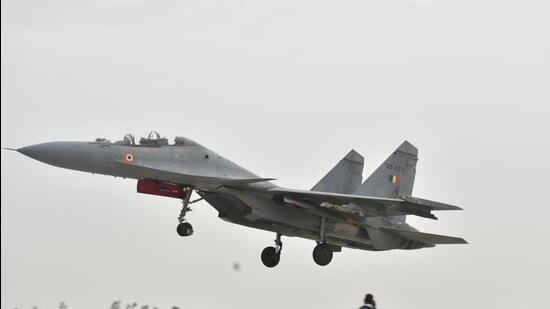2-day IAF combat drills in western sector begin tomorrow as tensions with Pakistan peak
India has issued a NOTAM (notice to airmen) regarding airspace restrictions in the exercise area in Rajasthan that extends towards the Pakistan border
NEW DELHI: The Indian Air Force (IAF) will on Wednesday begin a two-day combat exercise in the country’s western sector, with the aerial drills involving fighter planes, transport aircraft, airborne warning and control system (AWACS) aircraft, midair refuellers, helicopters and unmanned aerial vehicles, officials aware of the matter said on Tuesday.

The exercise will involve assets from airbases spread across Rajasthan, Gujarat, Haryana and Uttar Pradesh, the officials said, asking not to be named.
India has issued a NOTAM (notice to airmen) regarding airspace restrictions in the exercise area in Rajasthan that extends towards the Pakistan border, they added.
An IAF spokesperson said it was “a pre-planned, routine training exercise”.
Also Read: India’s America-China-Pakistan test of balance
The drills are taking place against the backdrop of simmering tensions between India and Pakistan that are threatening to reach a flashpoint in the aftermath of the April 22 Pahalgam terror strike that killed 26 people. The exercise also comes at a time when Pakistan continues to ratchet up tensions along the Line of Control (LoC) in Jammu and Kashmir.
“The exercise seeks to test the IAF’s combat readiness,” said one of the officials cited above. To be sure, the Indian and Pakistani militaries have carried out a series of drills, including missile launches, after the Pahalgam strike that sparked the worst crisis between the nuclear-armed neighbours since the 2019 Pulwama terror attack.
On Tuesday, the Pakistan Army escalated tensions along the LoC by firing at Indian posts in several sectors, including Kupwara, Baramulla, Poonch, Rajouri, Mendhar, Naushera, Sunderbani and Akhnoor, marking the 12 straight day of ceasefire violations, said another official.
The Indian Army’s counter-fire was measured but effective, he added.
Also Read: In Indus treaty pause, a reality check for Pakistan
The neighbouring army had opened fire in these eight sectors on Sunday and Monday too, the maximum number of areas it targeted on a single day after the Pahalgam terror attack that was reminiscent of the heyday of terrorism in the 1990s and 2000s and the worst strike on civilians in India since the 2008 Mumbai terror strikes.
The extensive ceasefire violations are being seen as a deliberate attempt by Pakistan to escalate tensions along the de facto border where it has rushed reinforcements to bolster its posture. The repeated targeting of Indian posts has sparked the most extensive cross-border exchange since the 2021 ceasefire.
During the last four days, Prime Minister Narendra Modi has been given a series of briefings by top officials on the operational readiness of the armed forces and the security dynamics in the region after the strike.
Modi has granted the military a free hand to respond forcefully to the Pahalgam terror attack and underlined that the armed forces have complete operational freedom to choose “the mode, targets, and timing of the response.”
On Wednesday, India will also conduct civil defence preparedness drills, including testing air raid warning sirens, training on civil defence protocols and crash blackout measures, as the government firms up its response to Pakistan in the aftermath of the attack.
The drills were ordered on Monday across the 244 civil defence districts. Drills on this scale have not been conducted in the country since 1971, when India defeated Pakistan in a war that led to the creation of Bangladesh.
Since the April 22 Pahalgam attack, India has unveiled several punitive measures, banning the import of goods originating in Pakistan, prohibiting Pakistan-flagged vessels from docking at Indian ports, shutting its airspace to aircraft registered in or operated by that country, suspending the 1960 Indus Waters Treaty, downgrading bilateral ties, expelling most Pakistani citizens in India, and shutting down the only operational land border crossing at Attari.
Pakistan has also unveiled tit-for-tat reactions to punitive measures announced by India but neither side has thus far indicated its intent to abandon the ceasefire. It has closed its airspace to Indian airlines, suspended all trade with India, and has threatened to suspend bilateral pacts such as the Simla Agreement.
India has significantly multiplied its offensive capabilities since the 2019 Balakot airstrikes in Pakistan, and during the border standoff with China, and the new weapons and systems it has modernised its arsenal with bring more options on the table as New Delhi weighs military action to punish Pakistan for being behind the Pahalgam terror attack.
The military hardware inducted to power the war machine includes Rafale fighter jets, S-400 air defence missile systems, Barak 8 air defence system, the indigenous aircraft carrier INS Vikrant, a raft of warships and submarines including the nuclear-powered ballistic missile submarine INS Arighaat, the Prachand light combat helicopters, the C-295 tactical transport aircraft, artillery guns and a new range of assault rifles.
The capability boost, which coincided with the military standoff with China in eastern Ladakh, covers a variety of unmanned systems, smart air-to-ground weapons, missiles, rockets, precision munitions, tank ammunition, high-tech surveillance systems and specialist vehicles.






